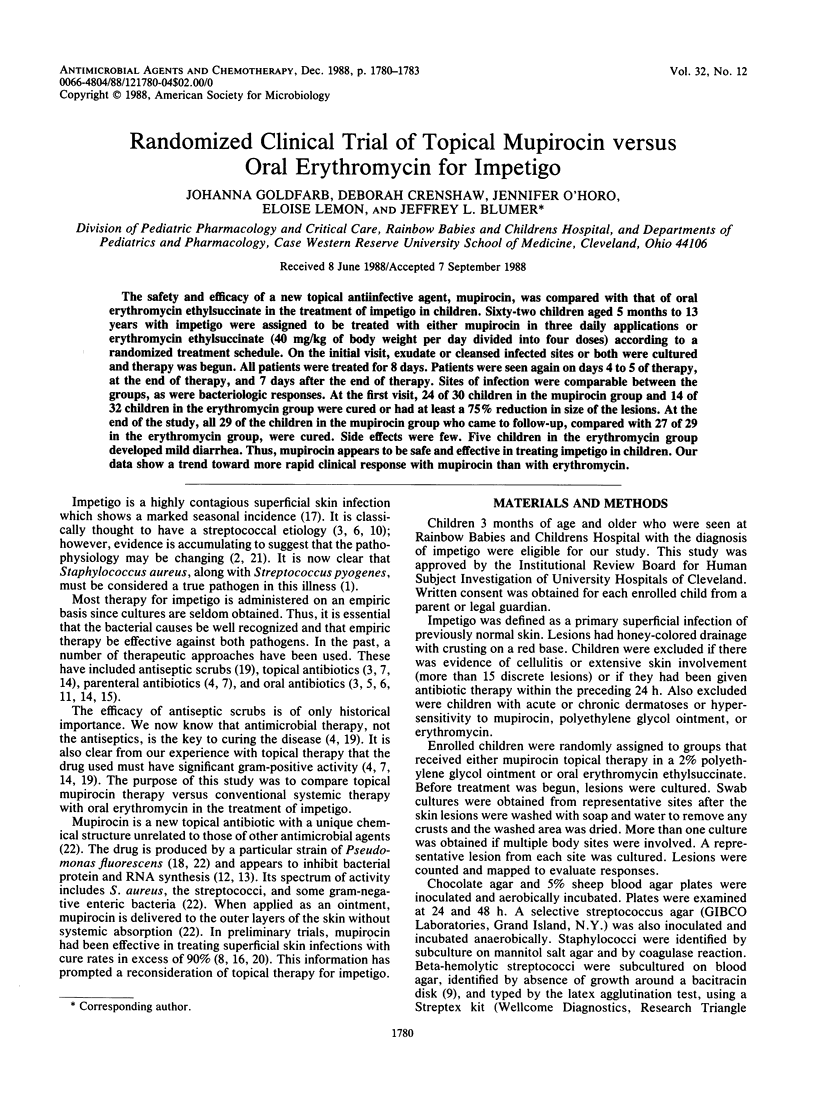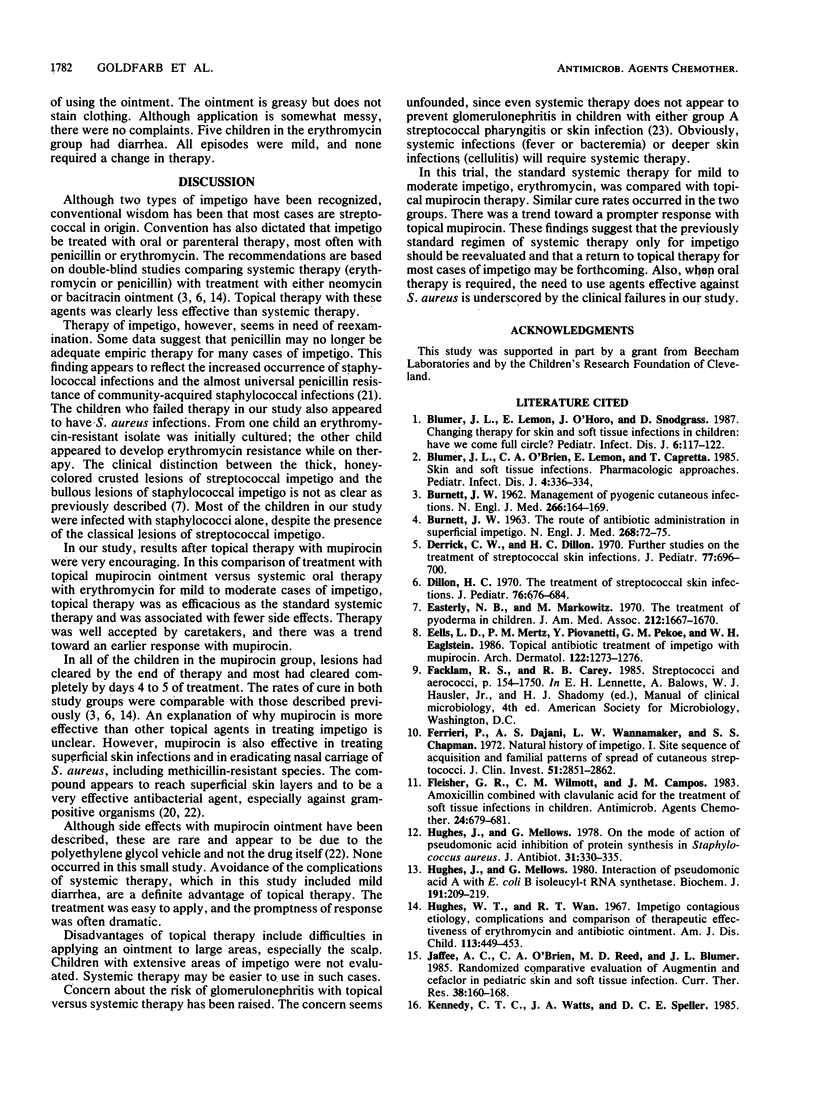Abstract
The safety and efficacy of a new topical antiinfective agent, mupirocin, was compared with that of oral erythromycin ethylsuccinate in the treatment of impetigo in children. Sixty-two children aged 5 months to 13 years with impetigo were assigned to be treated with either mupirocin in three daily applications or erythromycin ethylsuccinate (40 mg/kg of body weight per day divided into four doses) according to a randomized treatment schedule. On the initial visit, exudate or cleansed infected sites or both were cultured and therapy was begun. All patients were treated for 8 days. Patients were seen again on days 4 to 5 of therapy, at the end of therapy, and 7 days after the end of therapy. Sites of infection were comparable between the groups, as were bacteriologic responses. At the first visit, 24 of 30 children in the mupirocin group and 14 of 32 children in the erythromycin group were cured or had at least a 75% reduction in size of the lesions. At the end of the study, all 29 of the children in the mupirocin group who came to follow-up, compared with 27 of 29 in the erythromycin group, were cured. Side effects were few. Five children in the erythromycin group developed mild diarrhea. Thus, mupirocin appears to be safe and effective in treating impetigo in children. Our data show a trend toward more rapid clinical response with mupirocin than with erythromycin.
Full text
PDF



Selected References
These references are in PubMed. This may not be the complete list of references from this article.
- BURNETT J. W. Management of pyogenic cutaneous infections. N Engl J Med. 1962 Jan 25;266:164–169. doi: 10.1056/NEJM196201252660403. [DOI] [PubMed] [Google Scholar]
- BURNETT J. W. The route of antibiotic administration in superficial impetigo. N Engl J Med. 1963 Jan 10;268:72–75. doi: 10.1056/NEJM196301102680203. [DOI] [PubMed] [Google Scholar]
- Blumer J. L., Lemon E., O'Horo J., Snodgrass D. J. Changing therapy for skin and soft tissue infections in children: have we come full circle? Pediatr Infect Dis J. 1987 Jan;6(1):117–122. doi: 10.1097/00006454-198701000-00052. [DOI] [PubMed] [Google Scholar]
- Blumer J. L., O'Brien C. A., Lemon E., Capretta T. M. Skin and soft tissue infections: pharmacologic approaches. Pediatr Infect Dis. 1985 May-Jun;4(3):336–341. doi: 10.1097/00006454-198505000-00051. [DOI] [PubMed] [Google Scholar]
- Derrick C. W., Dillon H. C., Jr Further studies on the treatment of streptococcal skin infection. J Pediatr. 1970 Oct;77(4):696–700. doi: 10.1016/s0022-3476(70)80218-9. [DOI] [PubMed] [Google Scholar]
- Dillon H. C., Jr The treatment of streptococcal skin infections. J Pediatr. 1970 May;76(5):676–684. doi: 10.1016/s0022-3476(70)80284-0. [DOI] [PubMed] [Google Scholar]
- Eells L. D., Mertz P. M., Piovanetti Y., Pekoe G. M., Eaglstein W. H. Topical antibiotic treatment of impetigo with mupirocin. Arch Dermatol. 1986 Nov;122(11):1273–1276. [PubMed] [Google Scholar]
- Esterly N. B., Markowitz M. The treatment of pyoderma in children. JAMA. 1970 Jun 8;212(10):1667–1670. [PubMed] [Google Scholar]
- Ferrieri P., Dajani A. S., Wannamaker L. W., Chapman S. S. Natural history of impetigo. I. Site sequence of acquisition and familial patterns of spread of cutaneous streptococci. J Clin Invest. 1972 Nov;51(11):2851–2862. doi: 10.1172/JCI107108. [DOI] [PMC free article] [PubMed] [Google Scholar]
- Fleisher G. R., Wilmott C. M., Campos J. M. Amoxicillin combined with clavulanic acid for the treatment of soft tissue infections in children. Antimicrob Agents Chemother. 1983 Nov;24(5):679–681. doi: 10.1128/aac.24.5.679. [DOI] [PMC free article] [PubMed] [Google Scholar]
- Hughes J., Mellows G. Interaction of pseudomonic acid A with Escherichia coli B isoleucyl-tRNA synthetase. Biochem J. 1980 Oct 1;191(1):209–219. doi: 10.1042/bj1910209. [DOI] [PMC free article] [PubMed] [Google Scholar]
- Hughes J., Mellows G. On the mode of action of pseudomonic acid: inhibition of protein synthesis in Staphylococcus aureus. J Antibiot (Tokyo) 1978 Apr;31(4):330–335. doi: 10.7164/antibiotics.31.330. [DOI] [PubMed] [Google Scholar]
- Hughes W. T., Wan R. T. Impetigo contagiosa: etiology, complications, and comparison of therapeutic effectiveness of erythromycin and antibiotic ointment. Am J Dis Child. 1967 Apr;113(4):449–453. doi: 10.1001/archpedi.1967.02090190095008. [DOI] [PubMed] [Google Scholar]
- Parenti M. A., Hatfield S. M., Leyden J. J. Mupirocin: a topical antibiotic with a unique structure and mechanism of action. Clin Pharm. 1987 Oct;6(10):761–770. [PubMed] [Google Scholar]
- Ruby R. J., Nelson J. D. The influence of hexachlorophene scrubs on the response to placebo or penicillin therapy in impetigo. Pediatrics. 1973 Dec;52(6):854–859. [PubMed] [Google Scholar]
- Rumsfield J., West D. P., Aronson I. K. Topical mupirocin in the treatment of bacterial skin infections. Drug Intell Clin Pharm. 1986 Dec;20(12):943–948. doi: 10.1177/106002808602001204. [DOI] [PubMed] [Google Scholar]
- Schachner L., Taplin D., Scott G. B., Morrison M. A therapeutic update of superficial skin infections. Pediatr Clin North Am. 1983 Apr;30(2):397–404. doi: 10.1016/s0031-3955(16)34366-8. [DOI] [PubMed] [Google Scholar]
- Ward A., Campoli-Richards D. M. Mupirocin. A review of its antibacterial activity, pharmacokinetic properties and therapeutic use. Drugs. 1986 Nov;32(5):425–444. doi: 10.2165/00003495-198632050-00002. [DOI] [PubMed] [Google Scholar]
- Weinstein L., Le Frock J. Does antimicrobial therapy of streptococcal pharyngitis or pyoderma alter the risk of glomerulonephritis? J Infect Dis. 1971 Aug;124(2):229–231. doi: 10.1093/infdis/124.2.229. [DOI] [PubMed] [Google Scholar]


